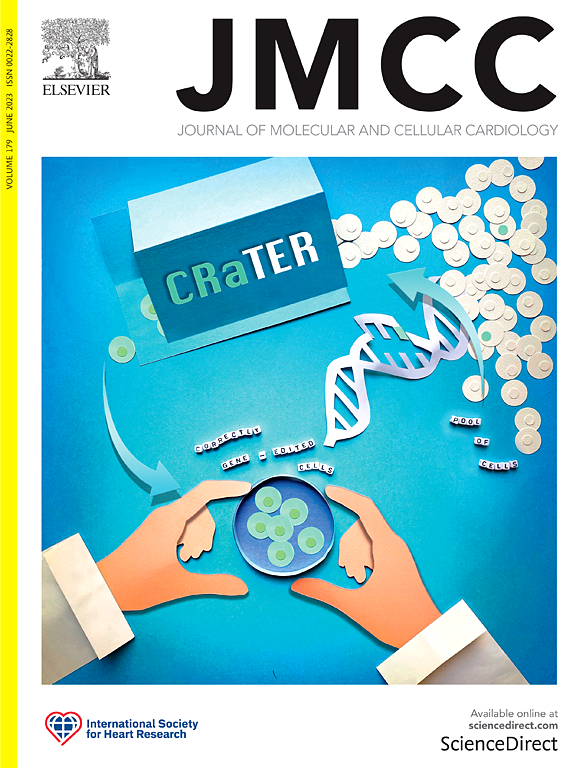筛选原肌球蛋白的单核苷酸变化以鉴定新型心肌病突变体
IF 4.7
2区 医学
Q1 CARDIAC & CARDIOVASCULAR SYSTEMS
引用次数: 0
摘要
遗传性心肌病是一类广泛的心脏病,包括病理性心脏重塑,如肥厚性和扩张性心肌病,影响全球1/250-1/500人。在许多情况下,构成肌节(收缩的基本亚细胞单位)的蛋白质突变改变了细纤维的调节,是肥厚和扩张性心肌病的根本原因。最初,代偿可以维持心脏功能,因此患者可能在主要心脏病发作前几年保持无症状。早期治疗干预可以挽救突变的有害影响,从而避免病理性重塑,因此预测尚未表征且意义不确定的已知突变的潜在结果和严重程度至关重要。为了实现这一目标,我们从含有肌动蛋白、原肌凝蛋白和肌钙蛋白的调节B和c状态的细丝结构开始,将所有潜在的单核苷酸突变纳入原肌凝蛋白序列(超过1700个独特突变),然后在能量最小化后测量原肌凝蛋白和肌动蛋白之间的相互作用能。对由此产生的数据库的分析表明,原肌凝蛋白残基导致原肌凝蛋白-肌动蛋白相互作用的巨大变化,因此最有可能对功能有害。其中一些突变体已经在人类患者中观察到,而另一些则是新的。全局分析进一步细化了影响肌动蛋白相互作用的突变敏感、盘绕型原肌球蛋白残基的热点。总之,该数据库将使研究更深入地关注功能分析的关键候选对象,例如,通过分析体外运动和工程心脏组织力学以及评估动物模型的结果。本文章由计算机程序翻译,如有差异,请以英文原文为准。

Screening single nucleotide changes to tropomyosin to identify novel cardiomyopathy mutants
Inherited cardiomyopathy is a broad class of heart disease that includes pathological cardiac remodeling such as hypertrophic and dilated cardiomyopathy, affecting 1/250–1/500 people worldwide. In many cases, mutations in proteins that make up the sarcomere, the basic subcellular unit of contraction, alter thin filament regulation and are the root cause of hypertrophic and dilated cardiomyopathy. Initially, compensations can maintain cardiac function, so patients may remain asymptomatic for years before a major cardiac episode. Early therapeutic intervention could rescue the deleterious effects of mutations thereby avoiding pathological remodeling, so prediction of potential outcomes and severity of as yet uncharacterized and known mutants of uncertain significance is critical. To accomplish this goal, we begin with the structure of the thin filament containing actin, tropomyosin, and troponin in its regulatory B- and C-states, incorporate all potential single nucleotide mutations to the tropomyosin sequence (over 1700 unique mutations), and then measure the interaction energy between tropomyosin and actin after energy minimization. Analysis of the database thus generated shows the tropomyosin residues resulting in large changes in tropomyosin-actin interaction, and therefore most likely to be deleterious to function. Some of these mutants have been observed in human patients, whereas others are novel. Global analysis further refines hotspots of mutation-sensitive, coiled-coil tropomyosin residues affecting actin interactions. Altogether, the database will allow research to focus in great depth on key candidates for functional analysis, for instance, by assaying in vitro motility and engineered heart tissue mechanics and assessing outcomes in animal models.
求助全文
通过发布文献求助,成功后即可免费获取论文全文。
去求助
来源期刊
CiteScore
10.70
自引率
0.00%
发文量
171
审稿时长
42 days
期刊介绍:
The Journal of Molecular and Cellular Cardiology publishes work advancing knowledge of the mechanisms responsible for both normal and diseased cardiovascular function. To this end papers are published in all relevant areas. These include (but are not limited to): structural biology; genetics; proteomics; morphology; stem cells; molecular biology; metabolism; biophysics; bioengineering; computational modeling and systems analysis; electrophysiology; pharmacology and physiology. Papers are encouraged with both basic and translational approaches. The journal is directed not only to basic scientists but also to clinical cardiologists who wish to follow the rapidly advancing frontiers of basic knowledge of the heart and circulation.

 求助内容:
求助内容: 应助结果提醒方式:
应助结果提醒方式:


